SH-SecNet: An Enhanced Secure Network Architecture for the Diagnosis of Security Threats in a Smart Home
Abstract
:1. Introduction
2. Related Works
2.1. Benefits That Occur from Smart Home
2.1.1. Request Response Programs
2.1.2. Load Shedding Programs
2.1.3. Effective Feedback
2.1.4. Peak Shaving Capabilities
2.2. Attacks in Smart Home-Smart Grid
2.2.1. Man-In-The-Middle (MITM) Attack
2.2.2. Man-In-The-Browser (MITB) Attack
2.2.3. Denial of Service (DoS) Attack
2.2.4. Attack against Home Monitoring and Control
2.3. Security Challenges and Issues in Smart Home-Smart Grid
2.3.1. Threatening of Energy Consumption Reporting
2.3.2. Attack Aiming the Demand Response Signal
2.3.3. Issues with the Load Shedding Signal for ESI/HAN
2.3.4. Issue against NAN Aggregator
2.4. Existing Researches
2.5. Multivariate Correlation Analysis (MCA)
3. Proposed SH-SecNet Architecture
3.1. SH-SecNet Architecture Overview
- Wired: This includes many traditional transmission infrastructures, such as electric wiring, coaxial cables, optical fibers, and telephones lines. HomePlug is widely adopted for power line communication and is mostly used for high-speed communication. Some other wired technology standards are X10, KNX, LonWorks, MoCA, and Insteon [42,43].
- Security layer: In SH-SecNet, the security mechanism is composed of many security attributes, which we have applied to our model. The security mechanism is used to analyse and protect the home network. It analyses the request and response data between home devices such as a health care system, multimedia, and an energy management system, and network technologies like those which are wired and wireless.
3.2. Threat Analysis Flow
3.3. MCA Detection Analysis
- Step1. Requirement of Observed traffic record , normal profile and Parameter
- Step2. Generate for the observed traffic record
- Step3.
- Step4. If then
- Step5. Return normal
- Step6. else
- Step7. Return attack
- Step8. End if
3.4. Security Analysis of Proposed Architecture
3.4.1. Confidentiality
- (1)
- Signature generationTo sign a message ‘m’ by device A, using A’s private key
- Compute e = H (m). Here, ‘H’ is a cryptographic hash function like SHA − 1.
- Select a random integer n from [1, z − 1]
- Compute r = p1 (mod z), here (p1, q1) = n × G. If r = 0, go to step 2.
- Compute s = n − 1(e + × r) (mod z). If s = 0, go to step 2
- The signature is the pair (r, s)
- (2)
- Signature verificationFor device ‘B’ to authenticate A’s signature, B must have A’s public key
- Prove that r and s are integers in [1, z − 1]. If it is not, the signature is invalid
- Estimate e = H (m)
- Estimate k = s − 1 (mod z)
- Compute t1 = ek (mod z) and t2 = rk (mod z)
- Calculate (p1, q1) = G + t2 ×
- The signature is valid if p1 = r (mod z), invalid otherwise
3.4.2. Integrity by Digital Watermarking
3.4.3. Ensuring Authenticity and Non-repudiation
4. Experimental Results and Analysis
4.1. Evaluation Dataset
4.2. Evaluation Process
4.3. Performance Comparisons
4.4. Comparison with Existing Researches and Discussions
5. Conclusions
Acknowledgments
Author Contributions
Conflicts of Interest
References
- Ahvar, E.; Daneshgar-Moghaddam, N.; Ortiz, A.M.; Lee, G.M.; Crespi, N. On analyzing user location discovery methods in smart homes: A taxonomy and survey. J. Netw. Comput. Appl. 2016, 76, 75–86. [Google Scholar] [CrossRef]
- Toschi, G.M.; Campos, L.B.; Cugnasca, C.E. Home automation networks: A survey. Comput. Stand. Interfaces 2017, 50, 42–54. [Google Scholar] [CrossRef]
- Alam, M.R.; Reaz, M.B.I.; Ali, M.A.M. A review of smart homes—Past, present, and future. IEEE Trans. Syst. Man Cybern. 2012, 42, 1190–1203. [Google Scholar] [CrossRef]
- Atzori, L.; Iera, A.; Morabito, G. The internet of things: A survey. Comput. Netw. 2010, 54, 2787–2805. [Google Scholar] [CrossRef]
- Siano, P.; Graditi, G.; Atrigna, M.; Piccolo, A. Designing and testing decision support and energy management systems for smart homes. J. Ambient Intell. Humaniz. Comput. 2013, 4, 651–661. [Google Scholar] [CrossRef]
- Sun, X.; Men, S.; Zhao, C.; Zhou, Z. A security authentication scheme in machine-to-machine home network service. Secur. Commun. Netw. 2015, 8, 2678–2686. [Google Scholar] [CrossRef]
- Wang, W.; Xu, Y.; Khanna, M. A survey on the communication architectures in smart grid. Comput. Netw. 2011, 55, 3604–3629. [Google Scholar] [CrossRef]
- Xu, L.D.; He, W.; Li, S. Internet of things in industries: A survey. IEEE Trans. Ind. Inf. 2014, 10, 2233–2243. [Google Scholar] [CrossRef]
- Ng, H.S.; Sim, M.L.; Tan, C.M. Security issues of wireless sensor networks in healthcare applications. BT Technol. J. 2006, 24, 138–144. [Google Scholar] [CrossRef]
- Yoon, S.; Park, H.; Yoo, H.S. Security issues on smarthome in IoT environment. In Computer Science and Its Applications; Springer: Berlin/Heidelberg, Germany, 2015; pp. 691–696. [Google Scholar]
- Wang, W.; Lu, Z. Cyber security in the Smart Grid: Survey and challenges. Comput. Netw. 2013, 57, 1344–1371. [Google Scholar] [CrossRef]
- Komninos, N.; Philippou, E.; Pitsillides, A. Survey in smart grid and smart home security: Issues, challenges and countermeasures. IEEE Commun. Surv. Tutor. 2014, 16, 1933–1954. [Google Scholar] [CrossRef]
- Bin, S.; Jun, L. Building Energy Efficiency Policies in China: Status Report. Available online: http://www.gbpn.org/reports/building-energy-efficiency-policies-china-status-report (accessed on 25 March 2017).
- SmartHouse/SmartGrid. Available online: http://cordis.europa.eu/pub/fp7/ict/docs/sustainable-growth/fp7-smarthouse_en.pdf (accessed on 24 November 2016).
- Siano, P. Demand response and smart grids—A survey. Renew. Sustain. Energy Rev. 2014, 30, 461–478. [Google Scholar] [CrossRef]
- Kok, K.; Karnouskos, S.; Nestle, D.; Dimeas, A.; Weidlich, A.; Warmer, C.; Strauss, P. Smart houses for a smart grid. In Proceedings of the 20th International Conference and Exhibition on Electricity Distribution-Part 1, CIRED, Prague, Czech Republic, 8–11 June 2009; IET: Hertfordshire, UK, 2009; pp. 1–4. [Google Scholar]
- Kamilaris, A.; Tofis, Y.; Bekara, C.; Pitsillides, A.; Kyriakides, E. Integrating web-enabled energy-aware smart homes to the smart grid. Int. J. Adv. Intell. Syst. 2012, 5, 15–31. [Google Scholar]
- Zhao, H.; Magoulès, F. A review on the prediction of building energy consumption. Renew. Sustain. Energy Rev. 2012, 16, 3586–3592. [Google Scholar] [CrossRef]
- Dougan, T.; Curran, K. Man in the browser attacks. Int. J. Ambient Comput. Intell. 2012, 4, 29–39. [Google Scholar] [CrossRef]
- Jacobsson, A.; Boldt, M.; Carlsson, B. A risk analysis of a smart home automation system. Future Gener. Comput. Syst. 2016, 56, 719–733. [Google Scholar] [CrossRef]
- Amer, M.; Naaman, A.; M’Sirdi, N.K.; El-Zonkoly, A.M. Smart home energy management systems survey. In Proceedings of the 2014 International Conference on Renewable Energies for Developing Countries (REDEC), Beirut, Lebanon, 26–27 November 2014; IEEE: Piscataway, NJ, USA, 2014; pp. 167–173. [Google Scholar]
- Han, J.; Choi, C.; Park, W.; Lee, I.; Kim, S. Smart home energy management system including renewable energy based on ZigBee and PLC. IEEE Trans. Consum. Electron. 2014, 60, 198–202. [Google Scholar] [CrossRef]
- Singh, S.; Jeong, Y.S.; Park, J.H. A survey on cloud computing security: Issues, threats, and solutions. J. Netw. Comput. Appl. 2016, 75, 200–222. [Google Scholar] [CrossRef]
- Zhou, B.; Li, W.; Chan, K.W.; Cao, Y.; Kuang, Y.; Liu, X.; Wang, X. Smart home energy management systems: Concept, configurations, and scheduling strategies. Renew. Sustain. Energy Rev. 2016, 61, 30–40. [Google Scholar] [CrossRef]
- Longe, O.M.; Ouahada, K.; Rimer, S.; Harutyunyan, A.N.; Ferreira, H.C. Distributed Demand Side Management with Battery Storage for Smart Home Energy Scheduling. Sustainability 2017, 9, 120. [Google Scholar] [CrossRef]
- Fan, Z.; Kulkarni, P.; Gormus, S.; Efthymiou, C.; Kalogridis, G.; Sooriyabandara, M.; Zhu, Z.; Lambotharan, S.; Chin, W.H. Smart grid communications: Overview of research challenges, solutions, and standardization activities. IEEE Commun. Surv. Tutor. 2013, 15, 21–38. [Google Scholar] [CrossRef]
- Keles, C.; Alagoz, B.B.; Kaygusuz, A. A note on demand side load management by maximum power limited load shedding algorithm for smart grids. In Proceedings of the 2015 3rd International Istanbul on Smart Grid Congress and Fair (ICSG), Istanbul, Turkey, 29–30 April 2015; IEEE: Piscataway, NJ, USA, 2015; pp. 1–5. [Google Scholar]
- Kuzlu, M.; Pipattanasomporn, M.; Rahman, S. Communication network requirements for major smart grid applications in HAN, NAN and WAN. Comput. Netw. 2014, 67, 74–88. [Google Scholar] [CrossRef]
- Acs, G.; Castelluccia, C. Dream: Differentially private smart metering. arXiv 2012. [Google Scholar]
- Huang, Y.; Li, H.; Campbell, K.A.; Han, Z. Defending false data injection attack on smart grid network using adaptive cusum test. In Proceedings of the 2011 45th Annual Conference on Information Science and System (CISS), Baltimore, MD, USA, 23–25 March 2011; IEEE: Piscataway, NJ, USA, 2011; pp. 1–6. [Google Scholar]
- Li, Y. Design of a key establishment protocol for smart home energy management system. In Proceedings of the 2013 Fifth International Conference on Computer Intelligence Communication System and Network (CICSyN), Madrid, Spain, 5–7 June 2013; IEEE: Piscataway, NJ, USA, 2013; pp. 88–93. [Google Scholar]
- Nabeel, M.; Kerr, S.; Ding, X.; Bertino, E. Authentication and key management for advanced metering infrastructures utilizing physically unclonable functions. In Proceedings of the 2012 IEEE Third International Conference on Smart Grid Communication (SmartGridComm), Tainan, Taiwan, 5–8 November 2012; IEEE: Piscataway, NJ, USA, 2012; pp. 324–329. [Google Scholar]
- Lee, E.; Oh, S.Y.; Gerla, M. Frequency quorum rendezvous for fast and resilient key establishment under jamming attack. ACM SIGMOBILE Mob. Comput. Commun. Rev. 2011, 14, 1–3. [Google Scholar] [CrossRef]
- Huang, Q.; Li, X.; Shaurette, M. Integrating Li-Fi wireless communication and energy harvesting wireless sensor for next generation building management. arXiv 2014. [Google Scholar]
- Huang, Q.; Zhang, Y.; Ge, Z.; Lu, C. Refining Wi-Fi based indoor localization with Li-Fi assisted model calibration in smart buildings. arXiv 2016. [Google Scholar]
- Tiwari, S.V.; Sewaiwar, A.; Chung, Y.H. Smart home multi-device bidirectional visible light communication. Photonic Netw. Commun. 2016, 33, 1–8. [Google Scholar] [CrossRef]
- Tiwari, S.V.; Sewaiwar, A.; Chung, Y.H. Color coded multiple access scheme for bidirectional multiuser visible light communications in smart home technologies. Opt. Commun. 2015, 353, 1–5. [Google Scholar] [CrossRef]
- Tan, Z.; Jamdagni, A.; He, X.; Nanda, P.; Liu, R.P. A system for denial-of-service attack detection based on multivariate correlation analysis. IEEE Trans. Parallel Distrib. Syst. 2014, 25, 447–456. [Google Scholar]
- Tevari, G.M.; Goudar, R.H. Multivariate Correlation Analysis: An Approach to Detect DDoS Attacks in FTP. Serv. Int. J. Sci. Technol. Eng. 2016, 2, 424–427. [Google Scholar]
- More, K.K.; Gosavi, P.B. A Real Time System for Denial of Service Attack Detection based on Multivariate Correlation Analysis Approach. In Proceedings of the International Conference on Electrical, Electronics, and Optimization Techniques (ICEEOT 2016), Chennai, India, 3–5 March 2016; IEEE: Piscataway, NJ, USA, 2016; pp. 1125–1131. [Google Scholar]
- Lu, X.; Wang, P.; Niyato, D.; Kim, D.I.; Han, Z. Wireless networks with RF energy harvesting: A contemporary survey. IEEE Commun. Surv. Tutor. 2015, 17, 757–789. [Google Scholar] [CrossRef]
- DP Mendes, T.; Godina, R.; MG Rodrigues, E.; CO Matias, J.; PS Catalão, J. Smart home communication technologies and applications: Wireless protocol assessment for home area network resources. Energies 2015, 8, 7279–7311. [Google Scholar] [CrossRef]
- Vanus, J.; Smolon, M.; Martinek, R.; Koziorek, J.; Zidek, J.; Bilik, P. Testing of the voice communication in smart home care. Hum.-Centric Comput. Inf. Sci. 2015, 5, 1–22. [Google Scholar] [CrossRef]
- Spadacini, M.; Savazzi, S.; Nicoli, M. Wireless home automation networks for indoor surveillance: Technologies and experiments. EURASIP J. Wirel. Commun. Netw. 2014, 2014, 1–17. [Google Scholar] [CrossRef]
- Barenghi, A.; Bertoni, G.M.; Breveglieri, L.; Pelosi, G.; Sanfilippo, S.; Susella, R. A fault-based secret key retrieval method for ECDSA: analysis and countermeasure. ACM J. Emerg. Technol. Comput. Syst. 2016, 13, 8–23. [Google Scholar] [CrossRef]
- Chandrakala, A.; Rao, S.B. Providing security by HMAC algorithm in P2P reputation management using distributed identities and decentralized recommendation chains. Int. J. Innov. Res. Dev. 2015, 4, 1–4. [Google Scholar]
- Yan, X.; Zhang, L.; Wu, Y.; Luo, Y.; Zhang, X. Secure smart grid communications and information integration based on digital watermarking in wireless sensor networks. Enterp. Inf. Syst. 2017, 11, 223–249. [Google Scholar] [CrossRef]
- Lalani, S.; Doye, D.D. A novel DWT-SVD canny-based watermarking using a modified torus technique. J. Inf. Process. Syst. 2016, 12, 681–687. [Google Scholar]
- Im, H.; Kang, J.; Park, J.H. Certificate less based public key infrastructure using a DNSSEC. J. Converg. 2015, 6, 26–33. [Google Scholar]
- Cook, D. CASAS Smart Home Project. [Online]. 2012. Available online: http://www.ailab.wsu.edu/casas/ (accessed on 1 January 2017).
- Synnott, J.; Nugent, C.; Jeffers, P. Simulation of smart home activity datasets. Sensors 2015, 15, 14162–14179. [Google Scholar] [CrossRef] [PubMed]
- Mehdi, S.A.; Khalid, J.; Khayam, S.A. Revisiting traffic anomaly detection using software defined networking. Proceeding of International Workshop on Recent Advances in Intrusion Detection, Menlo Park, CA, USA, 20–21 September, 2011; Springer: Berlin/Heidelberg, Germany, 2011; pp. 161–180. [Google Scholar]
- Mantoro, T.; Ayu, M.A.; Binti Mahmod, S.M. Securing the authentication and message integrity for Smart Home using smart phone. Proceeding of 2014 International Conference on Multimedia Computing and Systems (ICMCS), Marrakech, Morocco, 14–16 April 2014; IEEE: Piscataway, NJ, USA, 2014; pp. 985–989. [Google Scholar]
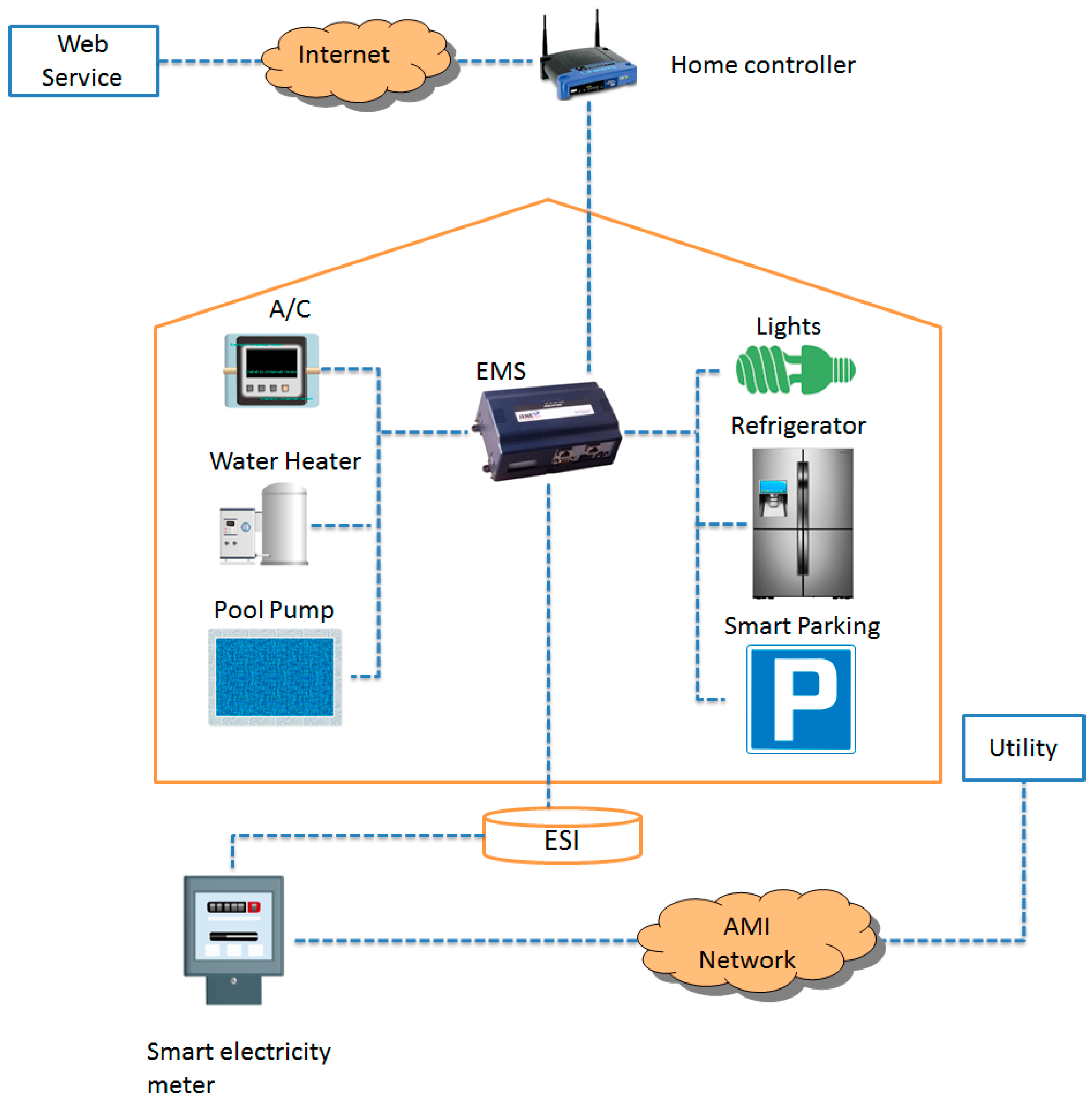

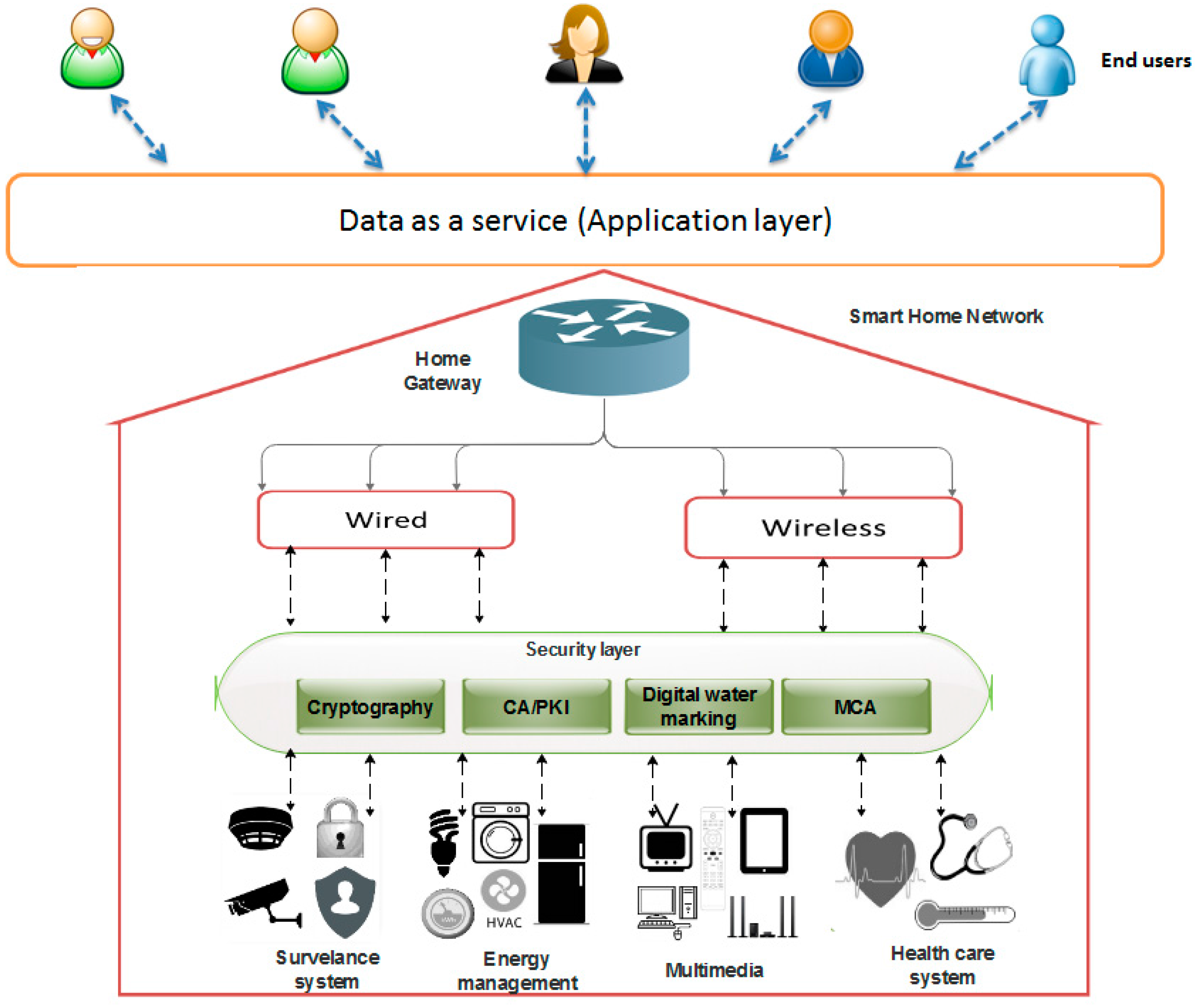
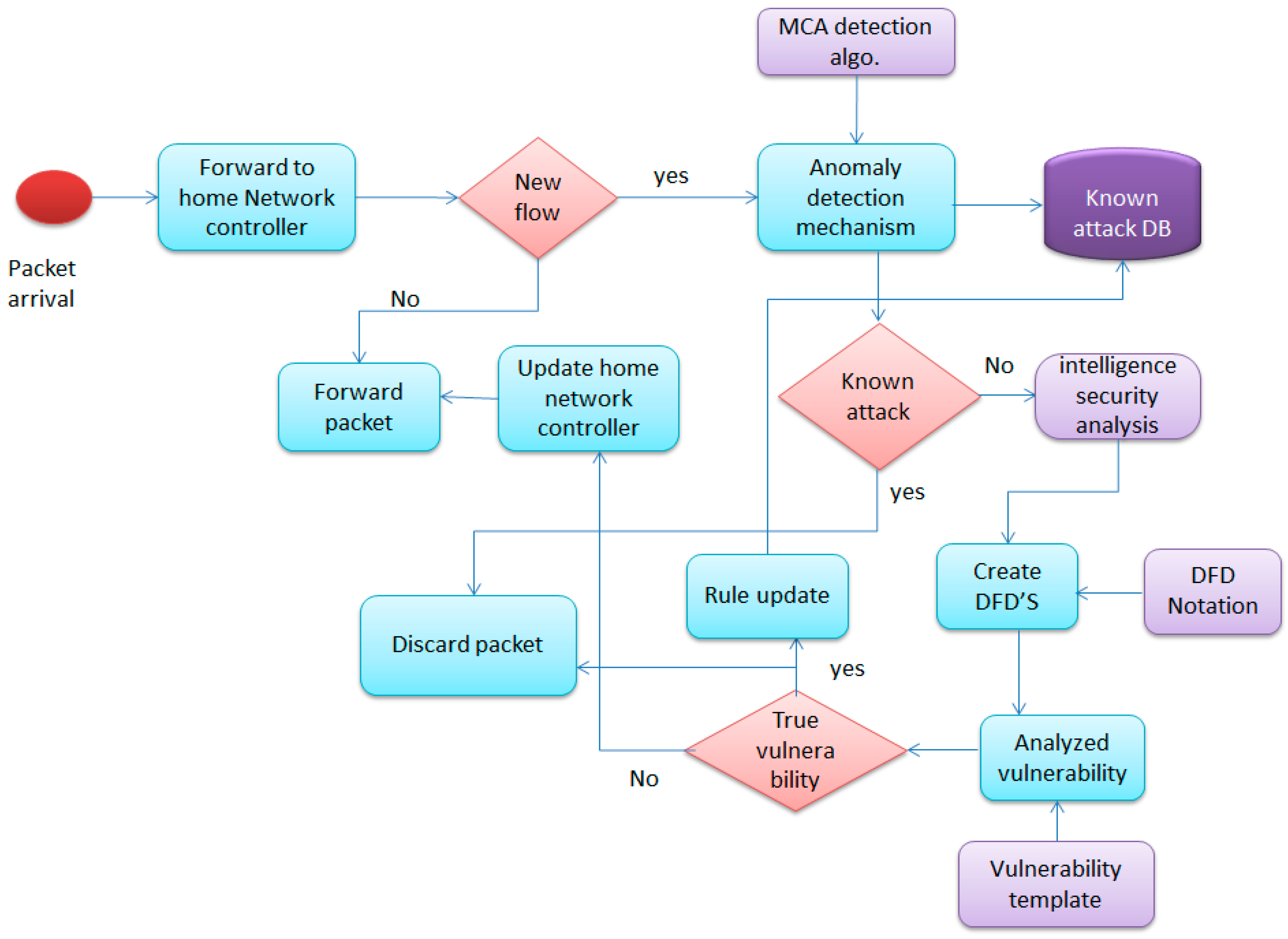
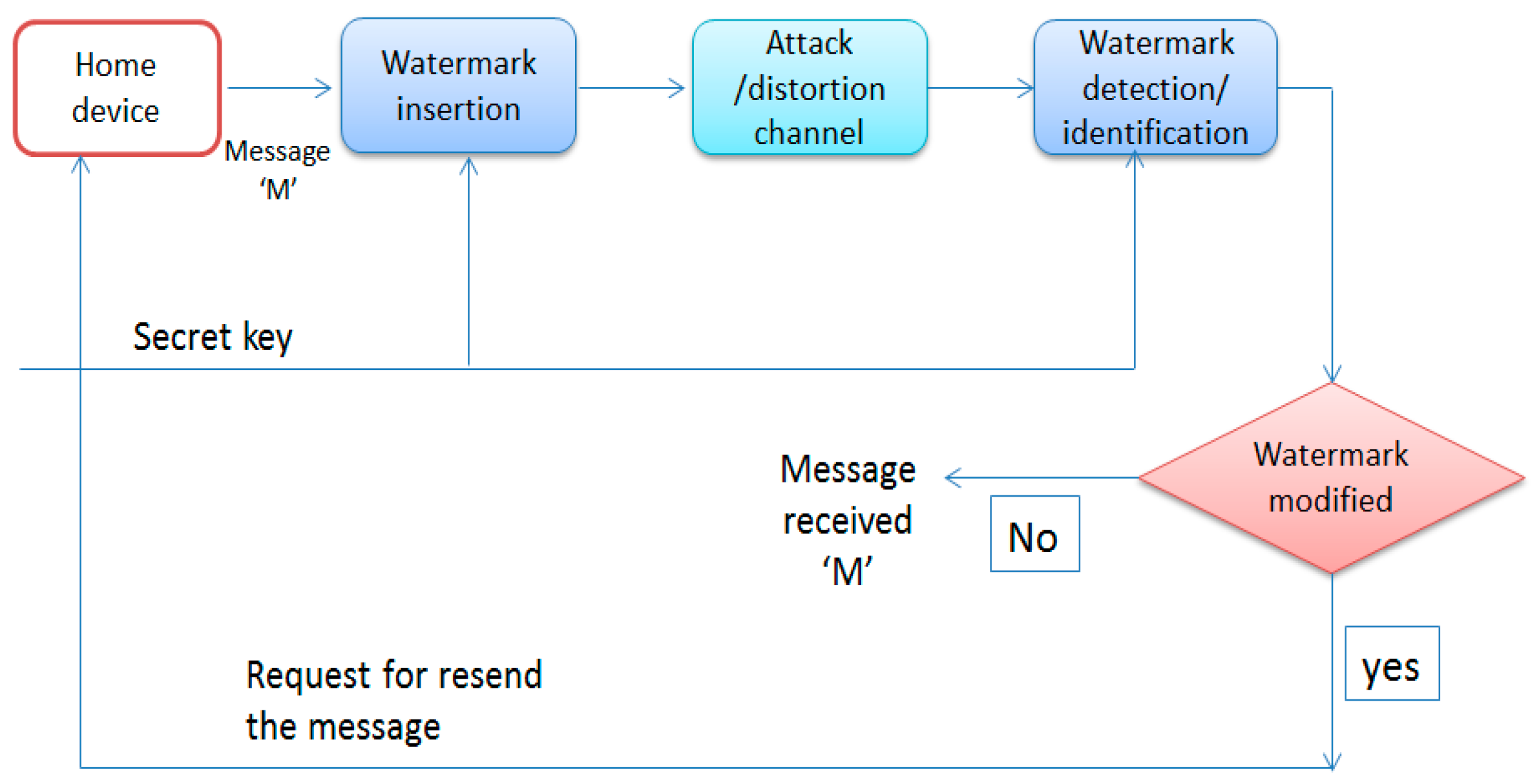
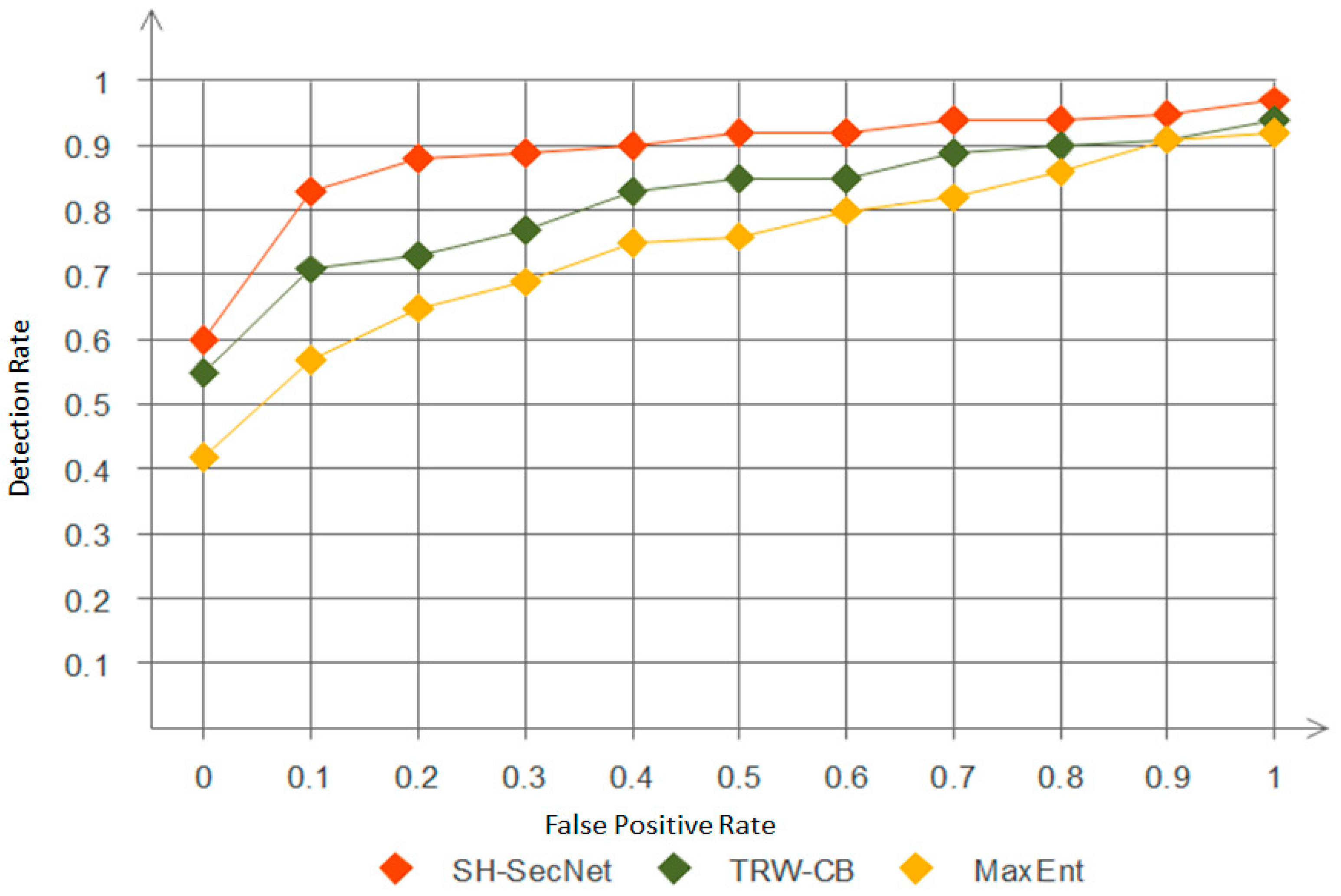
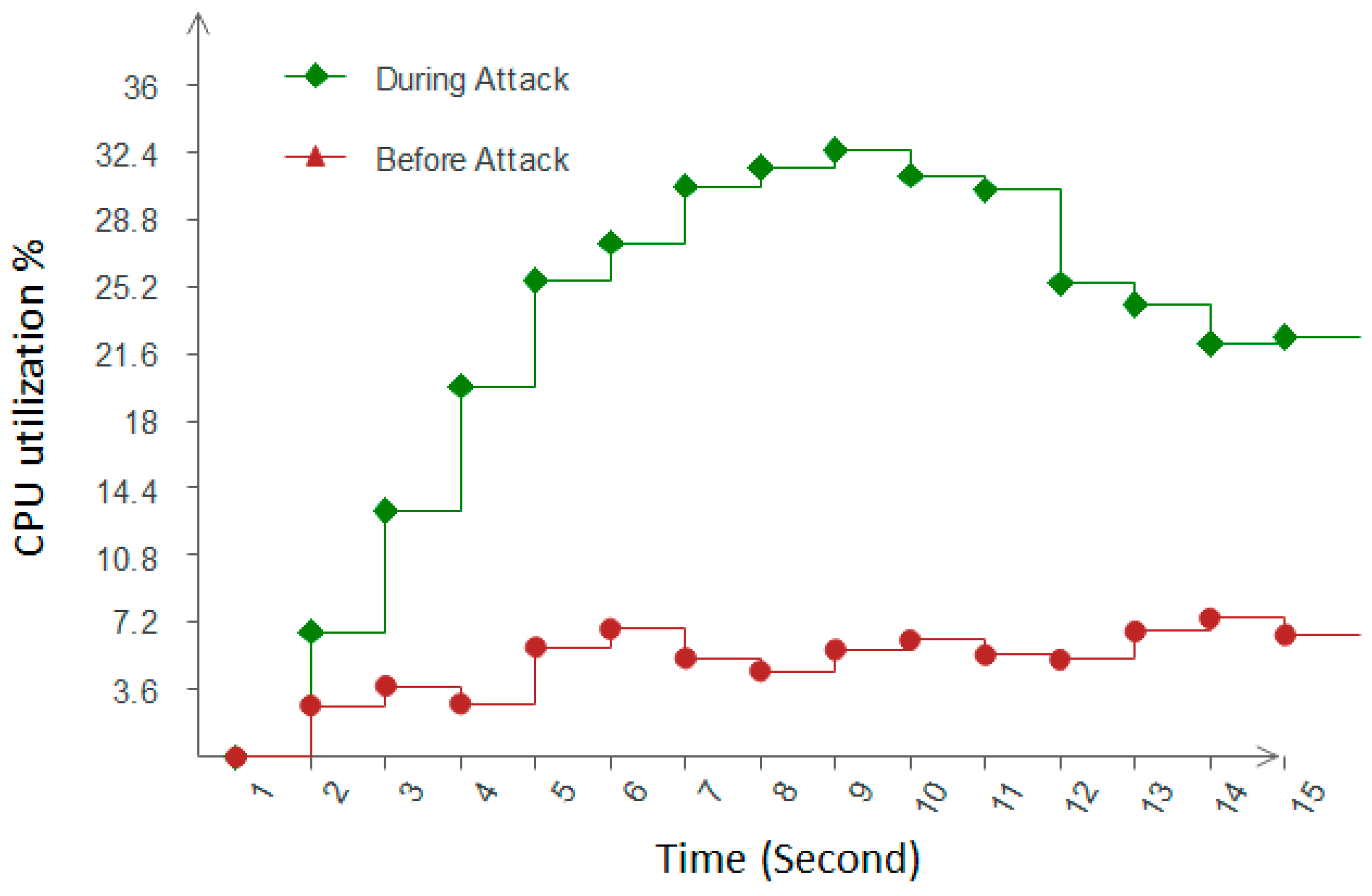


| Confidentiality | Integrity | Privacy | Authentication | Availability | |
|---|---|---|---|---|---|
| [29] | ✓ | ✓ | |||
| [32] | ✓ | ✓ | |||
| [33] | ✓ | ||||
| [40] | ✓ | ||||
| [52] | ✓ | ✓ | |||
| SH-SecNet | ✓ | ✓ | ✓ | ✓ | ✓ |
| Parameter | Percentage Improvement |
|---|---|
| Accuracy | 10%–15% |
| Throughput | 47%–55% |
| RTT | 24%–65% |
© 2017 by the authors. Licensee MDPI, Basel, Switzerland. This article is an open access article distributed under the terms and conditions of the Creative Commons Attribution (CC BY) license (http://creativecommons.org/licenses/by/4.0/).
Share and Cite
Singh, S.; Sharma, P.K.; Park, J.H. SH-SecNet: An Enhanced Secure Network Architecture for the Diagnosis of Security Threats in a Smart Home. Sustainability 2017, 9, 513. https://doi.org/10.3390/su9040513
Singh S, Sharma PK, Park JH. SH-SecNet: An Enhanced Secure Network Architecture for the Diagnosis of Security Threats in a Smart Home. Sustainability. 2017; 9(4):513. https://doi.org/10.3390/su9040513
Chicago/Turabian StyleSingh, Saurabh, Pradip Kumar Sharma, and Jong Hyuk Park. 2017. "SH-SecNet: An Enhanced Secure Network Architecture for the Diagnosis of Security Threats in a Smart Home" Sustainability 9, no. 4: 513. https://doi.org/10.3390/su9040513






